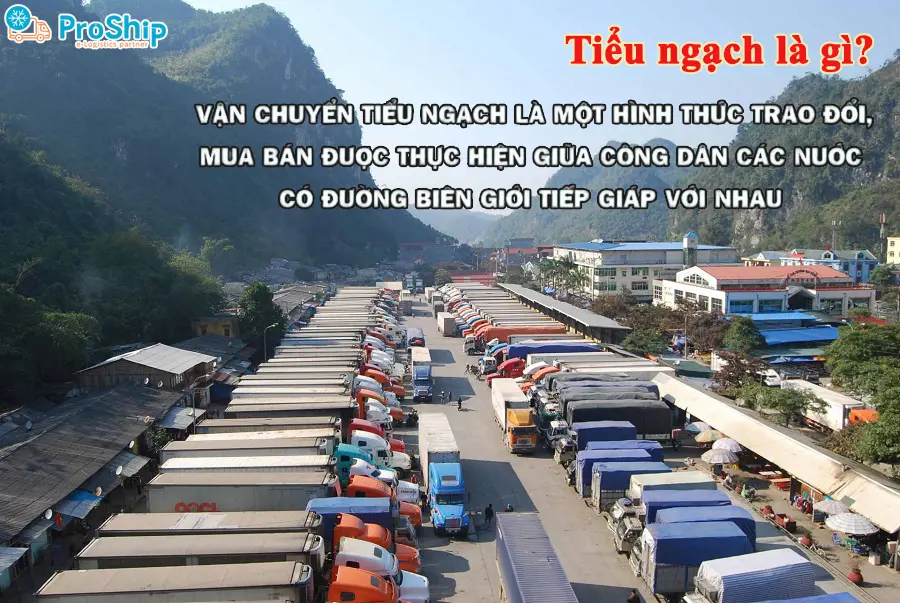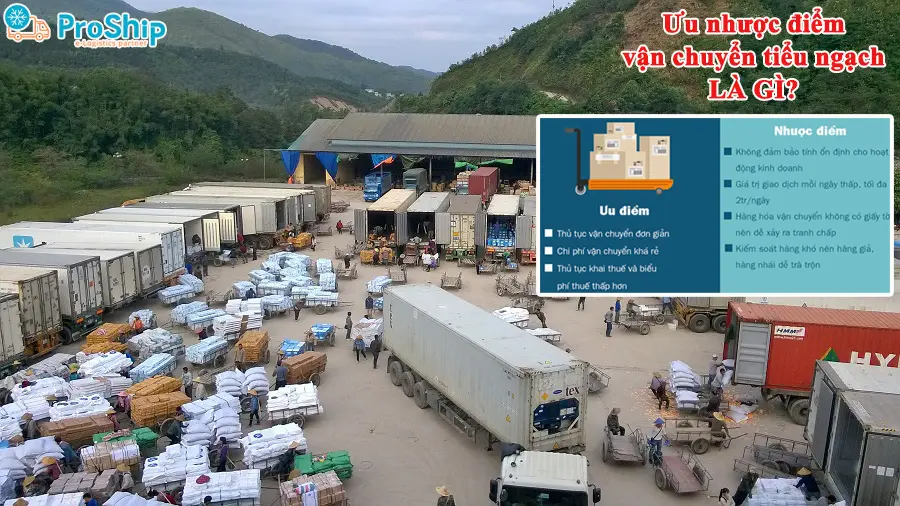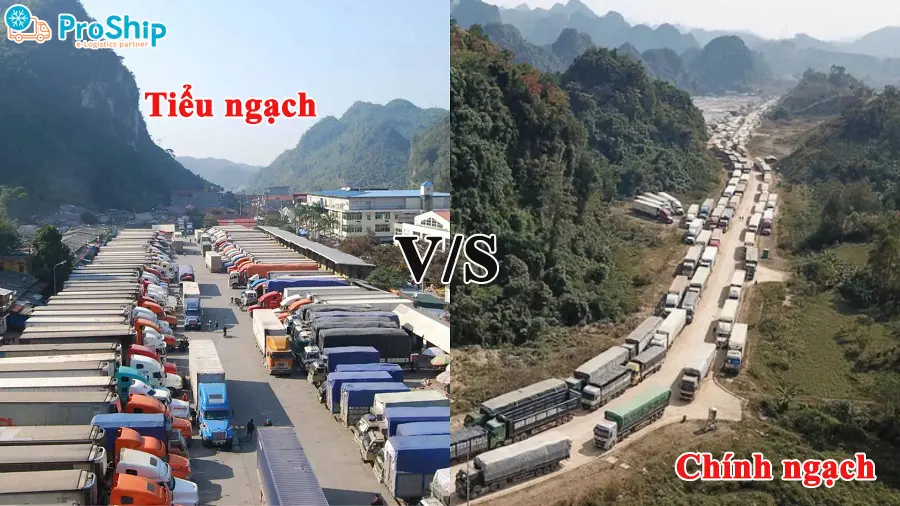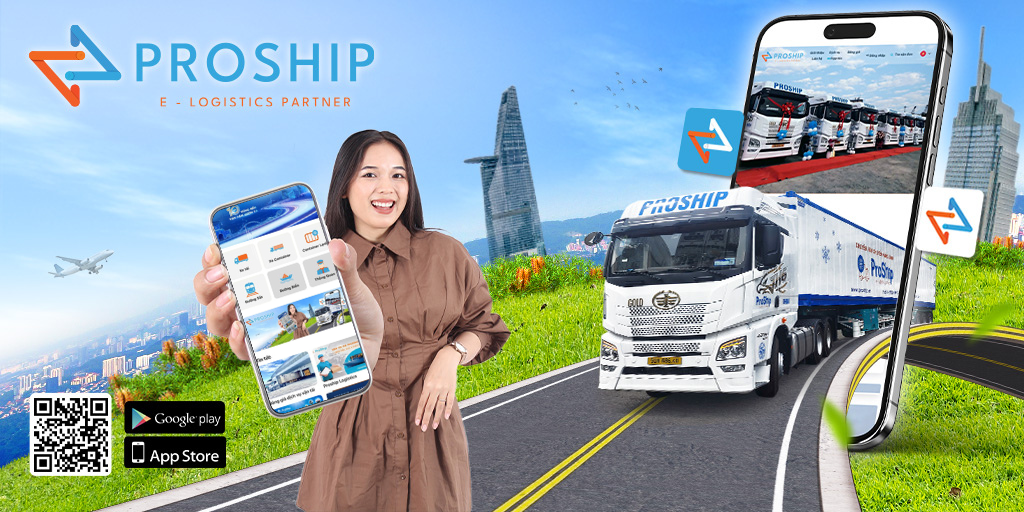x Bạn chưa hiểu rõ vận chuyển hàng tiểu ngạch là gì? Có ưu nhược điểm gì hay không? Quy trình, thủ tục vận chuyển ra sao?
x Các chủ hàng, doanh nghiệp xuất nhập khẩu, các shop kinh doanh online,…cần vận chuyển hàng từ Trung Quốc về nước và đang phân vân giữa hình thức chính ngạch với tiểu ngạch?
x Bạn chưa phân biệt được sự khác nhau giữa tiểu ngạch với chính ngạch?
Ngoài hình thức vận chuyển chính ngạch qua cửa khẩu, người tiêu dùng muốn giao thương hàng hóa với các nước sẽ có thêm sự lựa chọn với hình thức vận chuyển tiểu ngạch. PROSHIP.VN chúng tôi sẽ cập nhật nhanh kiến thức cần biết về tiểu ngạch là gì, quy trình vận chuyển hàng tiểu ngạch, ưu nhược điểm của tiểu ngạch và điểm khác nhau so với chính ngạch ra sao.
Tiểu ngạch là gì?
Tiểu ngạch là gì? Xuất nhập khẩu tiểu ngạch là một trong những hình thức trao đổi, buôn bán hàng hóa giữa người dân sinh sống ở gần biên giới giữa hai nước có đường biên giới liền kề nhau. Những người dân nước ta sống ở các vùng cửa khẩu ở một số tỉnh giáp biên với các nước láng giềng như Quảng Ninh, Lạng Sơn, Lào Cai,…

Các mặt hàng thường buôn bán qua đường tiểu ngạch gồm: nông sản, các mặt hàng tiêu dùng như quần áo, vải vóc,…Xuất nhập khẩu tiểu ngạch chính là một trong những hình mua bán hàng hóa, kinh doanh được nhiều thương lái ưa chuộng hiện nay vì thủ tục đơn giản, dễ dàng, chi phí vận chuyển thấp.
Đối tượng sử dụng Dịch vụ vận chuyển tiểu ngạch:
- Các hộ kinh doanh;
- Các cá nhân bán lẻ;
- Các tiểu thương tại các chợ, sạp;
- Các shop, cửa hàng hoặc các shop bán hàng online qua các kênh Thương mại điện tử,…
Ưu nhược điểm của xuất nhập khẩu tiểu ngạch
Ưu nhược điểm của hình thức vận chuyển hàng tiểu ngạch là gì? Đó chính là:
Ưu điểm của xuất nhập khẩu tiểu ngạch
Ưu điểm của hình thức xuất nhập khẩu tiểu ngạch:
- Quy trình thủ tục đơn giản, không đòi hỏi nhiều chứng từ, hóa đơn phức tạp. Chỉ cần điền tờ khai tiểu ngạch và chịu phí biên mậu là hàng hóa có thể thông quan;
- Các thủ tục khai thuế và biểu phí thuế cho hàng tiểu ngạch có mức phí thấp hơn so với chính ngạch;
- Chi phí vận chuyển tiểu ngạch rẻ hơn so với chính ngạch, giúp giảm gánh nặng tài chính cho người kinh doanh.

Nhược điểm của xuất nhập khẩu tiểu ngạch
Bên cạnh ưu điểm, xuất nhập khẩu tiểu ngạch cũng còn hạn chế nhất định:
- Không đảm bảo tính ổn định trong kinh doanh, đặc biệt đối với những ai kinh doanh các mặt hàng cao cấp;
- Tiểu ngạch dễ gây tranh chấp giá cả, chất lượng và các vấn đề khác;
- Mỗi giao dịch hàng ngày bị giới hạn giá trị, thường tối đa 2 triệu đồng/người/ngày nên chỉ phù hợp với buôn bán nhỏ lẻ;
- Hàng hóa dễ bị tráo với hàng kém chất lượng, khiến dễ bị cơ quan quản lý thị trường thu giữ khi kiểm tra.
Tiểu ngạch có gì khác so với chính ngạch?
Như trên, Proship đã giải đáp thắc mắc tiểu ngạch là gì, ưu nhược điểm của vận chuyển hàng tiểu ngạch là gì. Tiếp theo là bảng so sánh sự khác nhau giữa vận chuyển tiểu ngạch với vận chuyển chính ngạch:
| TIÊU CHÍ | VẬN CHUYỂN TIỂU NGẠCH | VẬN CHUYỂN CHÍNH NGẠCH |
|---|---|---|
| Hình thức vận chuyển | Không phải vận chuyển qua cửa khẩu mà theo một con đường riêng, không phải chịu sự kiểm tra khắt khe của cơ quan quản lý thị trường. Tuy nhiên, hàng hóa sẽ bị kiểm tra bất cứ lúc nào. | Vận chuyển qua cửa khẩu và phải đóng các loại thuế liên quan khá cao. Đồng thời phải chịu sự kiểm soát chặt chẽ của các cơ quan chuyên ngành. |
| Thủ tục xuất nhập khẩu | Không cần chuẩn bị nhiều giấy tờ, chỉ cần điền tờ khai tiểu ngạch và chịu phí biên mậu. | Cần chuẩn bị nhiều giấy tờ, chứng từ, hóa đơn liên quan, thủ tục khá phức tạp và phải chịu chịu mức thuế cao. |
| Giá trị giao dịch một ngày | Bị giới hạn giá trị giao dịch một ngày, không vận chuyển được số lượng hàng lớn. | Không bị hạn chế giá trị giao dịch, cho phép vận chuyển số lượng hàng hóa lớn. |
| An toàn hàng hóa | Quản lý hàng hóa lỏng lẻo, dễ bị trà trộn hàng và không đảm bảo được an toàn khi vận chuyển. | Hàng hóa được kiểm soát chặt hơn nên ít gặp rủi ro khi vận chuyển. |

>>Xem thêm: Chính ngạch là gì?
Thủ tục nhập khẩu và quy trình vận tải hàng tiểu ngạch
Thủ tục, quy trình vận chuyển hàng tiểu ngạch được tiến hành như sau:
Thủ tục nhập khẩu hàng tiểu ngạch
Theo Nghị định 14/2018/NĐ-CP, quy định chi tiết về hoạt động thương mại biên giới. Thông tư 80/2019/TT-BTC hướng dẫn thủ tục hải quan hàng thương mại biên giới. Thủ tục nhập khẩu tiểu ngạch qua biên giới được tiến hành như sau:
Thủ tục khai hàng
Các tổ chức, cá nhân được phép kinh doanh XNK tiểu ngạch qua biên giới. Khi có hàng XNK phải đến Hải quan cửa khẩu để làm thủ tục khai báo và nộp thuế. Để xuất nhập khẩu tiểu ngạch cần phải nộp:
- Tờ khai hàng theo mẫu HQ2019/TKXKBG hoặc HQ2019/TKNKBG;
- Xuất trình giấy phép chứng minh cư dân biên giới.
Thủ tục kiểm hóa
Thủ tục kiểm hóa được thực hiện như sau:
- Các tổ chức, cá nhân có hàng XNK tiểu ngạch biên giới phải đưa đến cửa khẩu và xuất trình hàng để hải quan kiểm tra;
- Căn cứ quy định của Tổng cục hải quan, tùy tính chất từng loại hàng cụ thể, trưởng Hải quan cửa khẩu quy định phương pháp kiểm tra cho thích hợp. Việc kiểm hóa phải tiến hành trước sự chứng kiến của chủ hàng;
- Cán bộ kiểm hóa tiến hành đối chiếu tờ khai và các giấy tờ có liên quan với thực tế hàng hóa xuất khẩu hoặc nhập khẩu để ghi kết quả kiểm hóa;
- Căn cứ giấy tờ khai báo và kết quả kiểm hóa, trưởng Hải quan cửa khẩu quyết định việc nộp thuế và cho hàng xuất khẩu hoặc nhập khẩu. Sau đó ghi chứng nhận thực xuất hoặc thực nhập và kết thúc thủ tục hải quan.
Việc luân chuyển giấy tờ
Việc luân chuyển giấy tờ phải tuân thủ:
- Trả lại chủ hàng 1 tờ khai hàng, 1 biên lai thu thuế nếu là hàng xuất nhập khẩu tiểu ngạch, hoặc 1 tờ CT13, nếu là hàng của cư dân biên giới;
- Lưu các giấy tờ còn lại tại hải quan cửa khẩu.
Quy trình vận tải hàng đường tiểu ngạch
Quy trình vận chuyển hàng tiểu ngạch gồm:
- Bước 1: Hàng hóa tập kết tại kho của Nhà vận chuyển thường là gần các Trung tâm mua bán, chợ, hoặc gần các khu xưởng sản xuất;
- Bước 2: Nhà vận chuyển nhận hàng, bao gói và viết biên nhận;
- Bước 3: Nhà vận chuyển bốc hàng lên xe tải vận chuyển tới khu vực tập kết hàng sát biên giới. Thường là các khu đất trống nằm sát biên giới;
- Bước 4: Từng bao hàng được các phu vác thồ trên vai bằng đường tắt qua bên kia biên giới và tập kết tại điểm tập trung;
- Bước 5: Hàng được bốc lên xe tải và chuyển về các thành phố lớn sau đó giao cho khách hàng;
- Bước 6: Bàn giao, xác nhận và thanh toán.
Proship Logistics đã chia sẻ kiến thức liên quan đến tiểu ngạch là gì, quy trình thủ tục vận chuyển hàng tiểu ngạch ra sao, ưu nhược điểm của vận chuyển tiểu ngạch là gì,…Doanh nghiệp, cá nhân quan tâm nên tìm đọc và áp dụng nếu đang phân vân giữa phương thức gửi hàng đường tiểu ngạch với chính ngạch. Mọi thắc mắc liên quan tới hàng tiểu ngạch là gì, liên hệ ngay 0909 344 247 sẽ có nhân viên tư vấn trực tiếp đến bạn.

